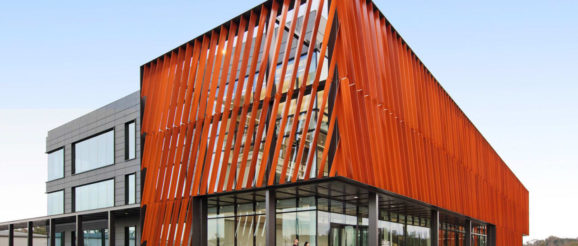Why Georgia’s Shaw Contract kept its innovation center close to home

Cartersville, Georgia, population 20,978, may be a surprising place to find a major corporate innovation hub, but one architecture firm’s creative approach to housing a bustling workplace in a rural Southern landscape proves that sometimes more room allows for greater design freedom.
Integrated architecture and design firm Gensler designed this new innovation hub for Shaw Contract, a commercial flooring company, in a city 42 miles north of Atlanta. The three-story, 67,000-square-foot think tank houses the company’s creative, marketing, and innovation teams under one very large roof. While most corporate office buildings divide employees by department, Gensler and Shaw decided that these ideation teams should share a single inspiring, collaborative space after analyzing the company’s mission. It’s a decision that, along with the choice to keep the innovation hub in rural Georgia, make the Shaw Create Center an unusual case study in workplace design.
The team used Gensler’s Workplace Performance Index, an online survey that the architects developed to analyze how people work in a particular company, in order to develop the best design. Gensler gives this survey to clients both before occupancy to gather employee input on their workplace prior to starting a design project, and after the completion of the project to measure the success of the proposed design solution.
This project is a winner of a 2019 Innovation by Design Award for the Workplace category. read more coverage of the winning designs here.
“The real takeaway was that for product development teams, the process of design usually doesn’t happen through a great idea. . . . It’s much more iterative,” says John Cantrell, the co-studio director and workplace and project director at Gensler Atlanta. “And I think today that iteration comes through trust.”
During the early design phase, Cantrell says that his team—along with Shaw’s—toyed with the idea of moving the Create Center to metro Atlanta. “This is a little bit unique in that most innovation hubs do usually happen in urban environments, just because of the ease of proximity, especially to talent,” he says.
But remaining a part of the community that has supported the flooring business for so long is what influenced Shaw—a company with a longstanding legacy in this north Georgia corridor—to stay put. Shaw Industries has been manufacturing carpet in Cartersville since 1967 and is the largest employer (to the tune of 3,100 associates and 8 facilities) in Georgia’s Bartow County.
“Shaw wanted to create a culture where there were people who were making things and people who were designing,” says Cantrell. “This was a workplace that was all about housing one idea and one culture, and through that innovation, the product’s process will happen faster because of that trust and proximity.”
In order to make the company’s profile more visible, the joint team decided to make the workspace and all of its offices semipublic. Thanks to a western-facing facade that allows direct sun to come in, members of the community can see inside the building when passing by—a nod to the company’s commitment to transparency. “Prior to this building, Shaw was tucked away into a place that looked like it was part of a manufacturing building,” says Cantrell.
In order to determine how to protect Shaw’s employees from glare and too much heat, Gensler’s designers and architects used computational design software called Galapagos. Some of the data Galapagos generated was used for the metal screen surrounding the building. As a result of these studies, the orientation of the louver fins was optimized for efficiency to reduce material use by 25%, Cantrell says. The study directly contributed to the design achieving a LEED Silver certification, in addition to being a WELL Building pilot facility.
Cantrell describes transparency as one of Shaw’s “key principles;” the company has published a corporate sustainability report every year since 2008, and it shares material ingredients with the public. To underline its commitment to transparency through its architecture, the company’s facilities are available to community members and corporate partners interested in Shaw’s operations. Inviting additions like an atrium and hospitality breakout space give Shaw’s creatives a view out to the community—and allow for the community to engage with Shaw, too.
